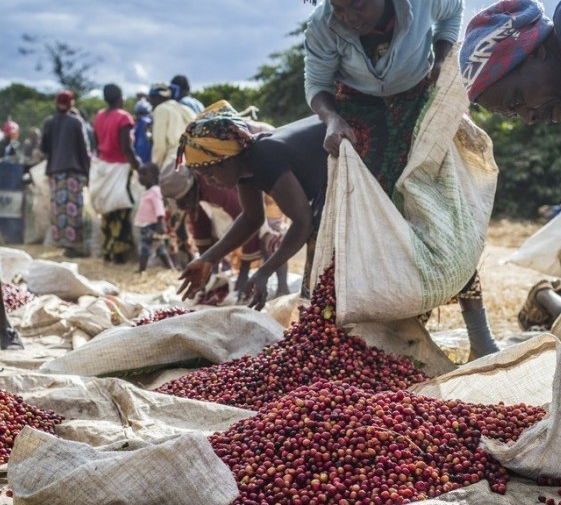What is the Ethiopian Red Cherry Project? Altland Manor in the sun Yega Chuefei
[coffee common sense] "Red Cherry Project"
About the Red Cherry Project OPERATION CHERRY RED
Speaking of the "Red Cherry Project", many friends are no stranger to this name. So what kind of project is the Red Cherry Project? Maybe only a few people can tell.
Ethiopia, known as the birthplace of coffee, has a large area of fine traditional coffee tree species. We know that Ethiopia is not a developed country with rich people's income. Agriculture and animal husbandry accounts for 80% of Ethiopia's population. In addition to growing coffee, there are rapeseed, beans, wheat and so on. An average of 200000 tons of coffee per year accounts for the main agricultural force in Ethiopia.
In order to improve the income of Ethiopian coffee farmers and improve the living standards of the local people, in 2007, Trabocca, a Dutch trader, launched the "OPERATION CHERRY RED PROJECT" Red Cherry Project with farmers from the producing areas. It is purely to encourage farmers to improve the quality of coffee beans. At the beginning of the harvest season in the producing area, Trabocca will specify a harvest plan for the microclimate area to harvest 100% ripe red coffee cherries by hand, with a yield of about 1500 kg-3000 kg.
The Red Cherry Project invested $5000 in 2008 to purchase new sun drying racks. In 2009, another $8000 was invested in the procurement of new sun drying racks and sunshade nets. A $9000 generator was invested in 2010 and a further $10000 was invested in 2011 to improve some local coffee transport roads to make transporting coffee more convenient and efficient. Trabocca offers interest-free loans to buy new coffee cherry meat removers and coffee bean sorters. In order to facilitate suppliers' procurement, a high-quality Addis Ababa coffee cup testing laboratory was built with an investment of US $14000 in 2012.
Trabocca provides financial loan support, new hardware equipment and production processing knowledge and technology to help farmers improve their production, promising to pay generous prices as long as the quality of actual output meets the cup test standards in Ethiopia's Addis Ababa and Amsterdama Cup in the Netherlands. The passing standard set by Trabocca is 88 points.
The coffee beans of the Red Cherry Project are immediately packed in plastic inner bags (GrainPro bags or vacuum box) immediately after the processing of the origin is completed, then shipped to Djibouti for shipping. Strive for perfect quality through immediate monitoring, safe transportation and timely and appropriate handling. As a result of this red cherry program, roasters can buy high-quality coffee beans, improve the quality of Ethiopian coffee and have better prices. Trabocca can also return profits to farmers, and continue to improve and improve the quality.
The average planting area of each small coffee farmer here is about 0.60 hectares, which is composed of hundreds of coffee growers with an altitude of nearly 2000 meters, a large climate difference and fertile soil, which provides an excellent growing environment. The raw bean itself gives off a strong aroma of raisins and fermented wine. The nearly yellowish-brown beans are actually small and slender, but the weight on the hands is very solid. After baking, we find that the bright berry aroma, or rich chocolate-like aftertaste, makes this bean have an eye-catching performance whether it is light baked or deep baked.
Flavor: berries, tropical fruits, fermented wine, jujube, tea, milk chocolate. Medium body, with a hint of spices and tea on the finish, is complex and long-lasting, tastes cleaner and more balanced after cooling.

Ethiopia Natural Yirgacheffe G1
Country: Ethiopia
Grade: G1
Producing area: Altrand Manor
Baking degree: shallow baking
Treatment: insolation
Variety: native species
Flavor: peach, cocoa, honey, lemon
Taobao link: https://item.taobao.com/item.htm?spm=a1z10.1-c.w4004-15673140431.8.31953ab8eyB3lj&id=555060132728
Important Notice :
前街咖啡 FrontStreet Coffee has moved to new addredd:
FrontStreet Coffee Address: 315,Donghua East Road,GuangZhou
Tel:020 38364473
- Prev

Learn the knowledge of "double baking", "fire baking", "fire baking" and "Nordic baking"
Heavy baking, fire baking Nordic baking among these many baking methods, we specially pick out heavy baking, fire baking and fire baking media for you. Let's start with the re-baking. Some people call it secondary baking, but literally, we can explain it very clearly. When we bake beans for the first time, we bake them over low heat until they are watered.
- Next

Selection skills of Italian coffee beans what is a cup of high quality espresso like
For professional baristas, please follow the coffee workshop (Wechat official account cafe_style) espress: 35 grams of essence extracted from 20 grams of coffee, in which the importance of coffee powder can be imagined. When buying coffee, it is better to buy coffee beans rather than ground coffee powder. although they are all the same in essence, the actual situation is that the ground coffee powder is very easy to oxygen.
Related
- Beginners will see the "Coffee pull flower" guide!
- What is the difference between ice blog purified milk and ordinary milk coffee?
- Why is the Philippines the largest producer of crops in Liberia?
- For coffee extraction, should the fine powder be retained?
- How does extracted espresso fill pressed powder? How much strength does it take to press the powder?
- How to make jasmine cold extract coffee? Is the jasmine + latte good?
- Will this little toy really make the coffee taste better? How does Lily Drip affect coffee extraction?
- Will the action of slapping the filter cup also affect coffee extraction?
- What's the difference between powder-to-water ratio and powder-to-liquid ratio?
- What is the Ethiopian local species? What does it have to do with Heirloom native species?

